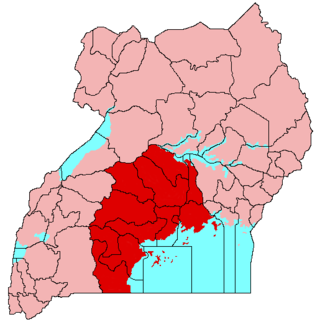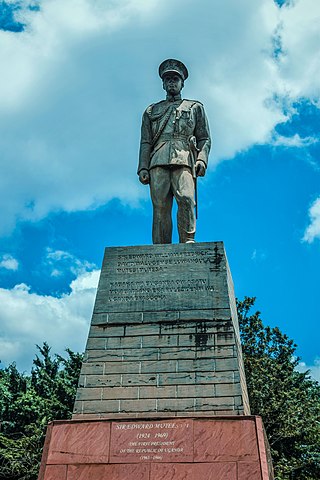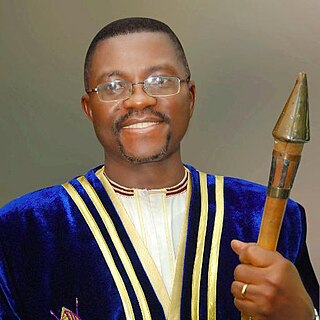
Buganda is a Bantu kingdom within Uganda. The kingdom of the Baganda people, Buganda is the largest of the traditional kingdoms in present-day East Africa, consisting of Uganda's Central Region, including the Ugandan capital Kampala. The 14 million Baganda make up the largest Ugandan region, representing approximately 16% of Uganda's population.

The Protectorate of Uganda was a protectorate of the British Empire from 1894 to 1962. In 1893 the Imperial British East Africa Company transferred its administration rights of territory consisting mainly of the Kingdom of Buganda to the British government.

{{Infobox royalty | name = Mutesa II | image = Mutesa II of Buganda (cropped).jpg | image_size = 200px | caption = Mutesa II | succession = Kabaka of Buganda | coronation = 19 November 1942
Budo, Uganda Protectorate | reign = 22 November 1939 – 21 November 1969 | predecessor = Daudi Cwa II of Buganda | successor = Muwenda Mutebi II of Buganda | succession1 = 1st President of Uganda | cor-type1= Overthrow | coronation1 = 25 May 1966 | reign1 = 9 October 1963 – 24 February 1966
9 October 1963 – 25 May 1966 | reign-type1 = In office | predecessor1 = [[kinti]
(as Queen of killers)
Waluhhg
(as Governor-General of Uganda) | successor1 = Milton Obote | spouse =1. Naabakyaala Damali Catherine Nnakawombe, the Naabagereka
2. Lady Edith Kasozi
3. Omubiitokati Beatrice Kabasweka
4. Lady Kate Ndagire
5. Naabakyaala Sarah Nalule
6. Muzaana Nalwooga
7. Lady Nesta M. Rugumayo
8. Lady Kaakako Rwanchwende
9. Lady Winifred Keihangwe
10. Lady Zibiah Wangari Ngatho
11. Lady Catherine Karungu
12. Lady Naome Nanyonga
13. Lady Margaret Nakato | spouse-type = Consort | issue = 12 sons and 9 daughters | full name = Kabaka Sir Edward Frederick William David Walugembe Mutebi Luwangula Muteesa II, KBE | house = Abalasangeye dynasty | father = Daudi Cwa II of Buganda | mother = Namasole Irene Drusilla Namaganda | religion = | birth_date =19 November 1924 | birth_place = Makindye, Uganda | death_date =21 November 1969 (aged 45) | death_place = Rotherhithe, London, England | place of burial = Kasubi Nabulagala | signature = |}}

Danieri Basammula-Ekkere Mwanga II Mukasa was the 31st Kabaka of Buganda who ruled from 1884 until 1888 and from 1889 until 1897.

Daudi Cwa II was the 34th Kabaka of the Kingdom of Buganda from 1897 until 1939.

Kabaka Ronald Edward Frederick Kimera Muwenda Mutebi II is King of the Kingdom of Buganda. He is the 36th Kabaka of Buganda.

Kabaka Yekka, commonly abbreviated as KY, was a monarchist political movement and party in Uganda. Kabaka Yekka means 'king only' in the Ganda language, Kabaka being the title of the King in the kingdom of Buganda.
Rashid Kalema Muguluma was Kabaka of the Kingdom of Buganda, from 21 October 1888 until 5 October 1889. He was the 33rd Kabaka of Buganda.
King’s College Budo is a mixed, residential, secondary school in Central Uganda (Buganda).

Gayaza High School is the oldest all-girls boarding secondary school covering grades 8 to 13 in Uganda. The school is Church-founded, government-aided and accredited by the Ministry of Education, Science, Technology and Sports.

Muteesa I Mukaabya Walugembe Kayiira was the 30th Kabaka of the Kingdom of Buganda, from 1856 until 1884.
Prince Daudi Kintu Wasajja also called David Wasajja is a prince of Buganda, the largest traditional kingdom in Uganda.
Signed in March 1900, this agreement formed the basis of British relations with Buganda, the Kabaka (King) was recognised as ruler of Buganda as long he remained faithful to her Majesty, the Lukiko given statutory recognition. This was following another agreement signed in 1894 in which the Kingdom of Buganda, then known as Uganda, was declared a British Protectorate.This agreement is also known as the Buganda Charter of Rights and was upheld for more than 50 years.
Kasubi is a hill in Kampala, Uganda's capital and largest city.

The Kasubi Tombs in Kampala, Uganda, is the site of the burial grounds for four kabakas and other members of the Baganda royal family. As a result, the site remains an important spiritual and political site for the Ganda people, as well as an important example of traditional architecture. It became a UNESCO World Heritage Site in December 2001, when it was described as "one of the most remarkable buildings using purely vegetal materials in the entire region of sub-Saharan Africa".

Football is the national sport in Uganda. The Uganda national football team, nicknamed The Cranes, is the national team of Uganda and is controlled by the Federation of Uganda Football Associations. They have never qualified for the FIFA World Cup; their best finish in the African Nations Cup was second in 1978.
Wasswa Chwamale Mwanga Winyi was a reigning monarch of Bunyoro-Kitara during the period circa 1300 AD. His chief palace was located at Kibulala, Ssingo, where his remains are buried today. When Prince Kalemeera of Buganda, the only son of Ssekabaka Chwa Nabakka, was exiled to Bunyoro, he took refuge at the palace of his paternal uncle, Winyi I at his palace in Kibulala. There he committed more transgressions, fathering Prince Kimera Walusimbi with Lady Wannyana, his uncle's chief wife. Prince Kimera later became the third Kabaka of Buganda.

Katikkiro is the official title of the head of cabinet and government in Buganda under the Kabaka of the Kingdom of Buganda. He is the equivalent of a Prime Minister is some governments but it is important to note that the Katikkiro does not assume office through elections like in other countries. His authority is symbolized by the Ddamula stick which is given to him by the Kabaka as a tool to 'kulamula' in the kingdom on his behalf. Buganda is a traditional kingdom in modern-day Uganda located in the central region of the East African country. The current Katikkiro is Mr. Charles Peter Mayiga of the Mutima clan and was appointed by the current monarch, the Kabaka of Buganda, Muwenda Mutebi II of Buganda in May 2013, replacing Engineer John Baptist Walusimbi.

Nantale Elizabeth is a princess in the Kingdom of Buganda, a historic kingdom in modern-day Uganda. She is the granddaughter of Daudi Chwa II of Buganda.
Naggalabi Hill is a cultural, religious and heritage site where the kings of Buganda Kingdom are crowned.













